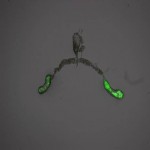
The recent Parasites and Vectors blog by Vera Unwin picked up on the attention given by the media to the encouraging announcements concerning the RTS,S malaria vaccine. This vaccine, as others have done, deploys the strategy of attacking the sporozoite stages of the parasite as they enter the body following the bite of an infected mosquito. However the vaccine is only partially efficacious and could not be used alone as a tool to control or eradicate malaria.
Since the late 1960s1 it has been recognised that inoculation with live irradiation-attenuated sporozoites, rather than a vaccine based on a small part of an abundant immunogenic sporozoite-surface protein, provides excellent protection. In the initial studies, immunization occurred via bites from infected mosquitoes; obviously not a feasible way to deliver a vaccine. Stephen Hoffman and his team at Sanaria Inc. have overcome this barrier by collecting sporozoites from aseptic mosquitoes, purifying them from mosquito material, and storing them as cryopreserved preparations before inoculation in controlled doses. The results of Phase I clinical trials of their radiation-attenuated Plasmodium falciparum sporozoite vaccine, PfSPZ Vaccine, to determine safely, immunogenicity and protective efficacy against controlled human malaria infection (CHMI) was reported in Science recently2. Inoculations were performed by an intravenous route (IV), following results from previous experimentation with non-human primates, and no breakthrough malaria infections occurred before the challenge of CHMI. Overall, a dose threshold was observed and six subjects who received five doses and three of nine subjects who received four doses obtaining complete protection from malaria. Thus, for this very small sample, the gold standard of 100% protection has been achieved in a clinical trial.
These initial results are very promising and a series of additional trials are now planned in Africa, Europe and the United States. However, even if this level of protection is maintained, is long lasting and effective for different age groups, there are huge logistical problems to overcome before a vaccine consisting of live attenuated sporozoites could reach the stage of development of RTS,S. For example; would this unusual inoculation route (IV has not previously been used for vaccine delivery) be tolerated, or could alternative delivery methods be developed? Compliance with a vaccination programme requiring several inoculations may be low in endemic countries and the attenuated sporozoites need to remain frozen before delivery, necessitating the maintenance of a cold chain in a rural African or Asian setting. Even more challenging may be the scale-up of the collection of sporozoites from infected mosquitoes, which already requires a large team of technicians. The ideal would be to grow the required malaria sporozoites in culture, but although this has been achieved2, methods are difficult to replicate and yields are very low. In spite of this, the conviction and persistence of Hoffman has paid off so far, and these problems may not be surmountable. What is certain is that the promise of a malaria vaccine that affords complete protection from disease is still likely to be a very long way off.
- Nussenzweig RS, Vanderberg J, Most H, Orton C. Protective immunity produced by the injection of x-irradiated sporozoites of Plasmodium berghei. Nature 1967; 216:160-2.
- Warburg, A and Miller, L.H. Sporogonic development of a malaria parasite in vitro. Science 1992; 255: 448-50.
<!–[endif]–>

Comments